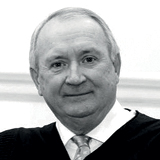“You tend to ruminate over some of the decisions that you make after you’ve finished court for the day. Was it the right decision? Was I too tough? Was I too soft? Did I miss something here? It’s a constant environment in which self-assessment plays an important part … It’s no easy environment, not for the faint-hearted.”
At least two respected Australian judges have passed in tragic circumstances in recent years. The deaths of Victorian Magistrate Stephen Myall in March 2018, and Queensland Judge Guy Andrew in October 2020, cast a spotlight on the heavy burdens judges bear through their work. In the wake of these tragedies, we explore the once-unspeakable topic of judicial stress.
Former High Court judge Michael Kirby once called it an “unmentionable” topic, but more than two decades later, attitudes have shifted. Judicial stress and how to manage it is firmly on the agenda for heads of jurisdiction and the judges and magistrates they oversee.
His Honour Judge Graeme Henson, Chief Magistrate of the NSW Local Court, told LSJ the issue of judicial stress is a “constant” topic of discussion among magistrates.
“I think once upon a time that was the case that if you said something you were perceived as being weak, but I don’t think that’s the case now,” he said. “I think we’ve come a long way in understanding the impact of stress in the work environment, and people are now more open about saying, ‘Look, I’m not coping, can you help?’ And where we can, we do.”
The first empirical research measuring judicial stress and wellbeing in Australia was published in June 2019. Judicial officers from five courts ranging from summary to appellate level participated in the research, which was conducted from mid-2016 to mid-2017. About 150 judges and magistrates completed a survey, with 60 of them also participating in an in-depth interview with the report’s author, lawyer and psychologist Carly Schrever.
Reflecting on changing attitudes both within the profession and the community, Schrever told LSJ that over the last five years the discussion has opened up, so much so that Australia is recognised as a leader in the region in the conversation on judges’ wellbeing.
“There’s been a real increase in the discussion, in the willingness at all levels in the judiciary to talk about the human dimension of judging and possible responses to the inevitable sources of stress within the role,” she said.
Schrever noted that although members of the judiciary identified dealing with distressing subject matter and traumatised victims as inherent pressures of the role, she was surprised by what judges and magistrates perceived as major sources of stress.
“What they tended to focus on were what I would call the extrinsic features of the judicial role,” she said. “Those environmental, structural, and organisational factors that define the context in which judicial officers work, rather than focusing on the intrinsic features of judging itself.”
Over the course of the research, participants described a range of workplace-related stressors including oppressive workloads, the pace of legislative change and the increasing complexity of the work, the public’s lack of faith in institutions including the courts, and criticism from government and the media. Where in decades past, Attorneys-General might have defended the courts and spoken on behalf of the judiciary, the perception among the profession was that there has been less adherence to that convention with the executive branch of government – that is, cabinet ministers – more willing to openly attack the courts.
 His Honour Judge Graeme Henson, Chief Magistrate of the NSW Local Court
His Honour Judge Graeme Henson, Chief Magistrate of the NSW Local Court
Immense caseloads
The NSW Local Court deals with more than 90 per cent of all criminal and civil cases and hears more than 80,000 bail applications each year. Last year saw notable increases in criminal and domestic and personal violence cases.
Chief Magistrate Henson cited “volume” as one of the significant factors exerting pressure on judicial officers, along with the complexity and the range of cases coming before the court, the immediacy required in particular matters, unrepresented litigants and sentencing arrangements. Judicial officers’ workloads are impacted by policy decisions, but in his view, governments tend to be more reactive than proactive when it comes to resourcing the courts.
“Courts are the product of demographics of the community and so when the population goes up, the likelihood of crime and other legal matters coming before a court is also likely to increase, and governments are rarely ahead of the game,” he told LSJ. “The judiciary is the meat in the sandwich waiting for government to understand the impact their decision making has on the court itself.”
A trial court judge from another jurisdiction told LSJ that while there are “excellent” orientation and induction programs for judges and magistrates, problems can still arise managing the day-to-day workload.
“There are many people who have to manage their own lists and regional courts are one of them,” said the judge. “You think, ‘I’ve got to hear all these cases’, and then you get left with a mountain of judgments and that’s when the weight really starts to affect you … it’s just a relentless stream of work.”
This judge believes that the concept of judicial independence can increase the stress and sense of isolation many judges experience.
“Everyone is fiercely protective of your independence, so no one will tell you how to do something. If you go and seek advice everyone is very collegial in that way, but in some ways, you are a rock and you’re left to have the waves crash over you.”
Coping strategies
According to Schrever, courts are looking at steps they can take to reduce judicial isolation, and many have implemented structural and systemic initiatives to alleviate the pressures on their judges and magistrates.
As well as access to annual health checks and a confidential 24-hour counselling service, the District Court of NSW has an Informal Judicial Support Group made up of sitting judges who can offer confidential assistance to judicial colleagues seeking support. New judges participate in an induction program and are enrolled in an orientation program, both of which include topics related to psychological health and welfare.
In the Family and Federal Circuit Courts, new judges undertake an in-depth induction program, and the courts offer a formal mentoring program, counselling, and judicial support and education via committees including the Judicial Wellbeing Committee. To reduce judges’ workload, those courts have implemented organisational change to enable registrars to manage some duty lists and deal with interlocutory disputes, and to undertake dispute resolution in suitable parenting and property cases.
In NSW, prospective Local Court magistrates participate in a two-day pre-bench orientation program where they undergo training on subjects ranging from how the courtroom functions to how different areas of the court and justice system interact. The Chief Magistrate uses the orientation program as an opportunity to raise awareness of the pressures of judicial life and the support that is available.
At the Court’s annual regional conferences, the Chief Magistrate conducts confidential one-on-one meetings with magistrates to discuss their welfare. He encourages them to have an annual health check through the justice health system and estimates that around 85 per cent do. Chief Magistrate Henson told LSJ that during his tenure, this approach has been successful in identifying magistrates who are struggling.
“We’ve picked up a few people who’ve been in distress – sometimes pride doesn’t allow them to admit that they’re under stress – but that’s one way we’ve short circuited the downstream consequences,” he said.
The Chief Magistrate reflects that the work of judicial officers is demanding. The impact of presiding over cases that involve distressing subject matter compounds over time, and the toll it takes is often underestimated.
“You tend to ruminate over some of the decisions that you make after you’ve finished court for the day. Was it the right decision? Was I too tough? Was I too soft? Did I miss something here? It’s a constant environment in which self-assessment plays an important part … It’s no easy environment, not for the faint-hearted.”




